Christopher Pothier Works in the Shadows
In his artist statement for “Wrangling With Shadows,” a new show at Bowersock Gallery (373 Commercial St., Provincetown), Christopher Pothier lists a handful of early modern and Renaissance artists who have inspired his work, including Pieter Breughel and Leonardo da Vinci. But there’s a moody precision to his strongly rendered oil on aluminum panels that also links them to 20th-century antecedents: Pothier’s tableaux incorporate something of the stark, haunted streetscapes and interiors of Giorgio di Chirico with the startling, surreal juxtapositions of René Magritte.
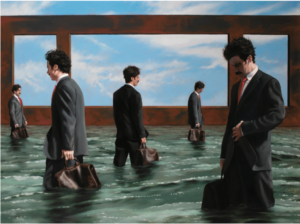
His A Coastal Monument to the Repeating Conformist, displayed in the gallery’s front window, particularly evokes the latter in its depiction of five seemingly identical iterations of the same briefcase-toting man walking their separate ways through a field of water, while windows in the background open onto an expanse of a very Magritte-like blue sky.
It’s a standout work in a show filled with similarly enigmatic and often disquieting images. But if Pothier’s work seems to explore the visual language of dreams, his working process is grounded in a specific reality. Pothier builds scale models for the spaces depicted in his paintings using Japanese rice paper and balsa wood and uses the models to experiment with different compositions and lighting effects. Figures are added to the “sets” in different poses and combinations before being photographed as the basis for the finished work. The results are paintings that blur distinctions between reality and imagination.
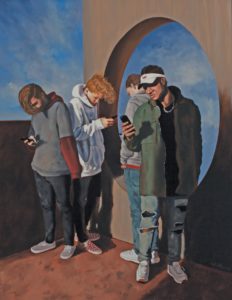
Just as nuanced is Pothier’s layered exploration of social, political, and interpersonal themes in his work. The four young figures in The Data Miners stand in close proximity to one another but remain isolated in their focused attention to the devices in their hands. The implicit message of the alienating effects of technology couldn’t be clearer. But the details of Pothier’s compositions often elevate his images from simple one-note readings. Here, the open portal the figures assemble around suggests a more existential disassociation — and possibly, an opportunity for transcendence. —John D’Addario
All in the Family
An exhibition of drawings, monoprints, and photographs by artists Rob DuToit and Janice Redman and their son, Alexander DuToit, is on view at Wellfleet Preservation Hall (335 Main St.) through Sept. 28. It’s the first time the three are showing their work together.
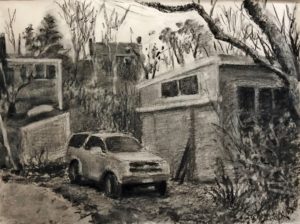
The work was created in their Truro home during the extended pandemic season of 2020 and 2021. “Alexander set up a darkroom in our house during Covid,” says Redman, “and started printing and developing medium format and 35mm film.” His photos reveal a keen talent for sharp, angular compositions in unexpected, peripheral places: his mother swimming, caught mid-stroke in a pool; light bouncing off lily pads; a stagnant abandoned boat. The rich black tones in his photos are particularly stunning.
In a series of charcoal drawings, Rob DuToit is similarly engaged with the outside world. He says these drawings provided an escape from his studio-based painting practice. “It was a relief to go out in nature,” he says. The images feel caressed into being, with a soft quality that conveys a rigorous precision in the way DuToit builds space through a wide range of light and dark values.
In a space adjacent to her son’s makeshift darkroom, Redman created small monoprints of organic objects that suggest nascent insect life or close-ups of wrapped objects. “I do them when I’m not doing sculpture,” Redman says. “The imagery comes through the working.” —Abraham Storer
Mitchell Johnson’s Ways of Looking
Mitchell Johnson first came to Truro in 2005, not long after he saw an exhibition in Italy that paired the work of Josef Albers with Giorgio Morandi. He describes it as a sort of revelation: “It was an affirmation of what I was trying to do.”
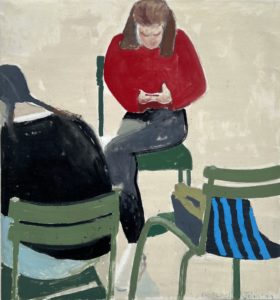
Combining Morandi’s close observation of forms in the natural world and Albers’s flat abstractions exploring color relationships, Johnson began to incorporate studies of Truro’s cottage architecture and the landscape along Shore Road into his work. It’s a process that continues.
Johnson’s “Nothing and Change: Selected Paintings 1990-2022” opens at Castle Hill (10 Meetinghouse Road, Truro) on Thursday, Sept. 8. One painting in the show, North Truro (Green Sun), depicts a cottage sandwiched between the sky and water. But Johnson’s vision isn’t confined strictly to the observed world. Here, the sun is green — and a black horizontal form sits in front of the cottage with no obvious reference to an actual object. The carefully observed scene becomes a framework upon which he can explore color relationships in the mode of Albers.
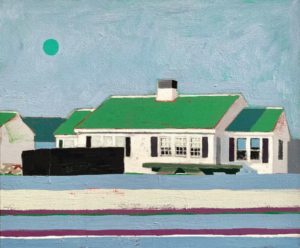
Similarly, in Red Sweater (Luxembourg), the article of clothing in the title becomes a precise but loosely painted flat red shape vibrating against the complementary greens of the chairs. The picture began as an observation of a scene in a park in Paris. But like many paintings in the show, it represents both Johnson’s fascination with the observed world and an interest in the abstract qualities of color relationships. —Abraham Storer
Old Ways and New Stories
Quilts tell stories. A multicolored never-waste-a-scrap crazy quilt tells us about the maker’s humble origins. A labor-intensive, impeccably stitched double wedding ring quilt tells us how beloved a pair of newlyweds were by the family members who made it. And in 19th-century America, quilts may even have been used to tell those fleeing enslavement which routes to take, where to sleep, and who they could trust along the Underground Railroad.

The communicative power of quilts has long fascinated Boston-based artist Maya Erdelyi, whose work is on view at Room 68 (377 Commercial St., Provincetown) this month. And although her newest work is technically a collection of paper collages, the pieces represent an unmistakable homage to quiltmaking and quiltmakers.
Using hundreds of pieces of precisely cut paper — culled from monoprints, silkscreens, books, magazines, and other sources — Erdelyi has painstakingly recreated traditional quilt blocks like flying geese, half-square triangles, and grandma’s flower garden. The almost blinding shock of her bold colors is an allusion to early quiltmakers’ sense of design and placement. And like the generations of quilters who preceded her, Erdelyi tells stories through her work. “Fragments of surviving a pandemic and the overturning of Roe v. Wade are woven into the fabric of the pieces,” she says. “There are clues, and also jokes if you look closely.”
A selection of more intimate smaller pieces in the show are no less intricate than her larger ones. And Erdelyi further updates traditional quilting by presenting some of her collages in a limited edition of animated light boxes. The show is on view until Sept. 22. —Richard Read
Zoë Lewis Serves Up a Slice
Zoë Lewis grew up in a small fishing village outside of Brighton, England and first alighted in Provincetown in 1991, where she played music on the street and eventually landed a gig at the Post Office Café. So, it’s appropriate that she’s sharing 30 years of her musical life in another small fishing village in the venue where it all began.

“A Slice of Ptown,” which Lewis debuted earlier this year, will begin its final run of four performances at the Post Office Café on Sunday, Sept. 11. (Another show is scheduled for Women’s Week next month.) Her onstage ensemble includes Parker Ousley on cello, Roxanne Layton on recorder, vocalist Qya Cristál, and an enigmatically glamorous co-star known simply as the Gorgeous Cigarette Girl.
Lewis says the spirit of the show is as much about preservation as it is about nostalgia. “I wanted to capture the feeling of what is still special about Provincetown,” she says. “People have been saying that it’s changed since Mary Heaton Vorse lived here. It has changed, and it will continue to change. But there’s still something here that you can’t find anywhere else in the world.”
The title of the show is a wink at where Lewis lived for 25 years: next door to Spiritus, which she calls the “spiritual nucleus” of the town. “Even in the days before theme weeks, I could always gauge what was going on simply by looking outside to see who was hanging out.”
The show features original songs that were written as Lewis discovered different aspects of Provincetown over the years, along with new material to create a narrative thread between them. “The longer I lived here, the more layers I would find,” says Lewis. “You first come to Provincetown and it’s all about the parties. Then you stick around for a while and start to meet the artists, the writers, the workers, and the foragers. After all this time, I’m still finding new layers to think and write songs about.
“People have told me these songs are a reminder of why they love Provincetown so much,” she says. “Everyone has their own stories about this place. This show is my way of sharing some of mine.” Visit postofficecafe.net for tickets and more information. —John D’Addario



